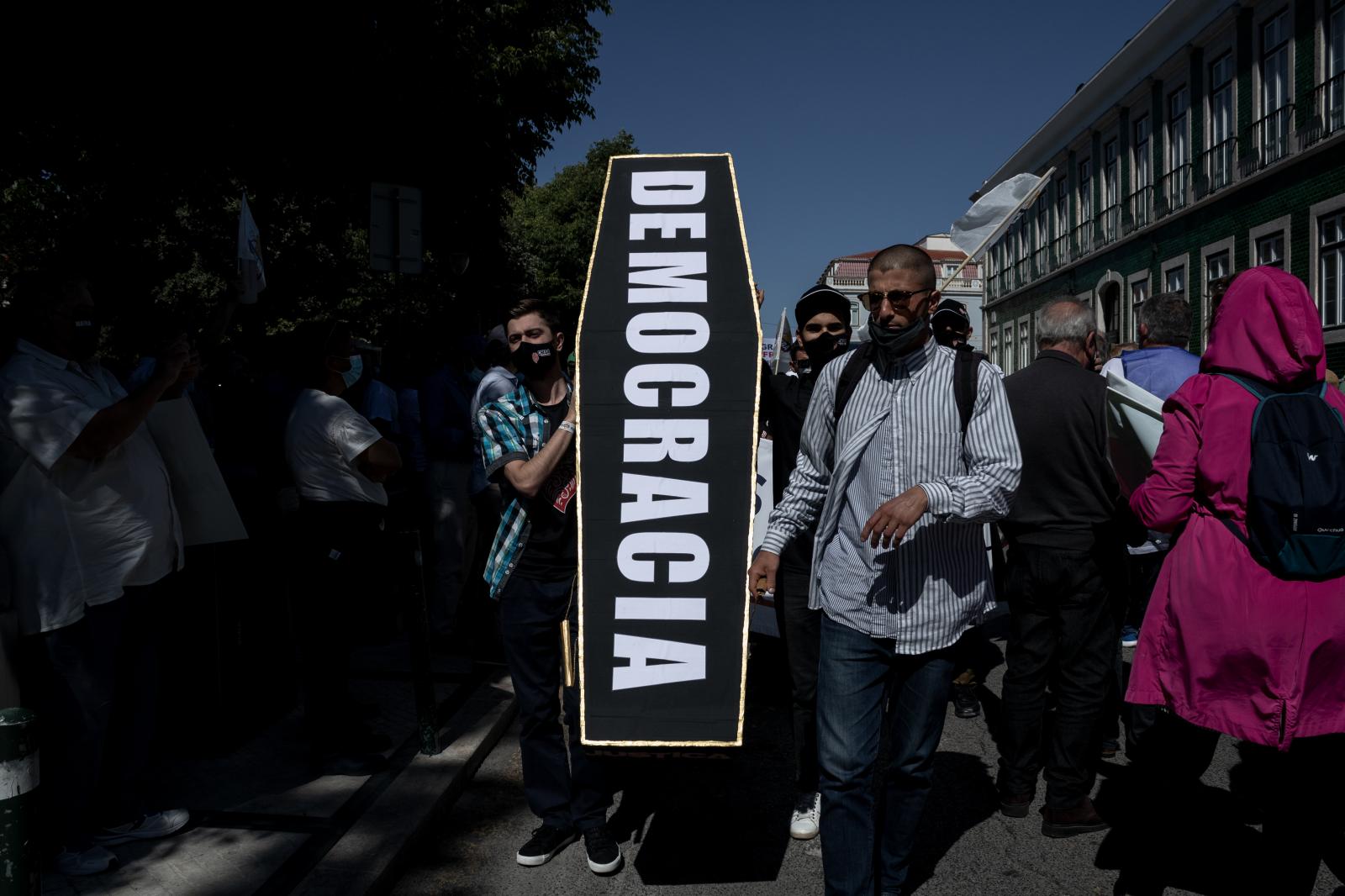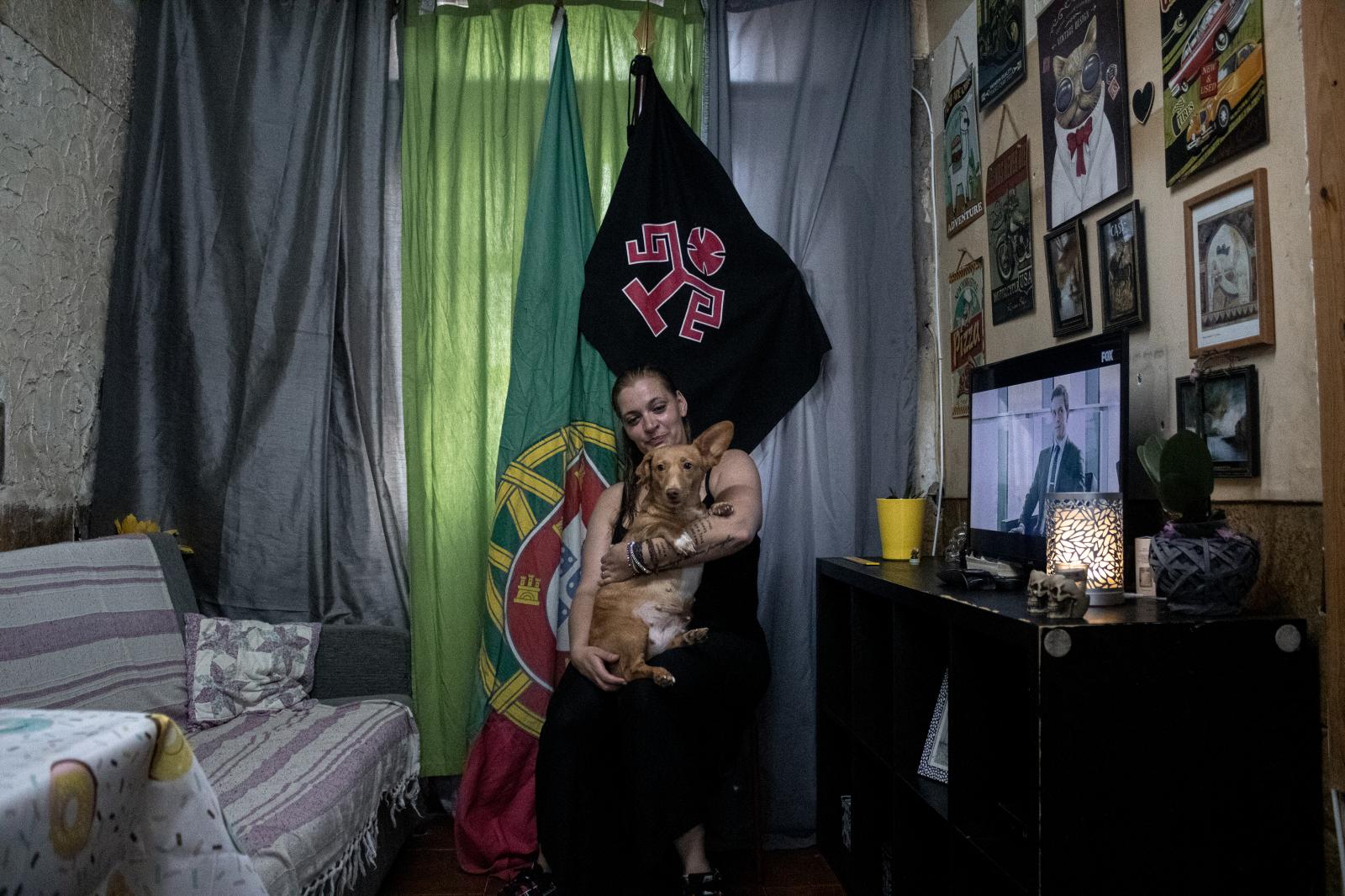Public Project
Os Pretorianos
Decidi começar pela leitura do livro Guia da Europa Negra, de Manuel Florentín, uma das obras mais relevantes jamais escritas sobre a evolução das correntes nacionalistas na Europa das décadas de 1970, 1980 e 1990. Contudo, afastei-me deliberadamente do tom académico do autor espanhol. Em vez disso, optei por um registo direto, em que as imagens falassem por si, dispensando definições exaustivas ou teorizações abstratas. Inspirei-me ainda no fotojornalista Espen Rasmussen, que, no seu trabalho Raiva (Rage, no original), retratou a vida de movimentos nacionalistas nos EUA e por toda a Europa — Oriental, Meridional, Setentrional e Ocidental. Percebi, então, que Portugal não constava da lista. Posto isto, coube-me a mim, um cidadão português, colmatar essa lacuna.
As 27 fotografias que compõem este trabalho foram captadas num clima de tensão latente. Apesar de muitos dos intervenientes me terem recebido com cordialidade, a desconfiança era uma constante. Nestes círculos, um repórter — independentemente da sua filiação política — é sempre um intruso. Foi precisamente essa dinâmica que quis destacar desde o início, deixando claro: «Não concordo convosco, mas pretendo compreender por que razão acreditam que a vossa visão do mundo é a mais correta.»
É evidente que iniciei este projeto com preconceitos. Alguns confirmaram-se; outros, não. Encontrei pessoas surpreendentemente bondosas, mas tão politicamente ingénuas que a sua postura só podia ser explicada por um ódio visceral ao mundo exterior — um ódio que as consumia lentamente. Isto, claro, não absolve o racismo ou a xenofobia que permeiam estes grupos. Há, aliás, quem promova o conflito étnico com um discurso pseudo-intelectual, como J. Martins, cuja influência tem transformado o movimento. Os nacionalistas contemporâneos — os que surgiram após o término deste trabalho — já não se assemelham aos skinheads violentos de outrora. Assumiram, em contrapartida, o papel de «defensores» de uma pátria alegadamente sitiada por «invasões estrangeiras» e pela dissolução da sua homogeneidade cultural.
This was my first big adventure. I was only nineteen, yet I yearned to accomplish something memorable—something no one had dared to achieve before: to document, in full and unfiltered detail, the Portuguese nationalist landscape. Prior to this project, the scarce existing works on the subject were limited to fragmented approaches—isolated profiles of figures within the movement, never substantively clarifying their true influence or that of the ideology they represented.
I decided to begin by reading Guia da Europa Negra (Black Europe Guide) by Manuel Florentín, one of the most significant works ever written on the evolution of nationalist movements across Europe in the 1970s, 1980s, and 1990s. However, I deliberately distanced myself from the Spanish author’s academic tone. Instead, I opted for a direct approach, letting the images speak for themselves, free from exhaustive definitions or abstract theorising. I also drew inspiration from photojournalist Espen Rasmussen, who, in his work Rage, documented the lives of nationalist movements in the US and throughout Europe—Eastern, Southern, Northern, and Western. It struck me then that Portugal was missing from that list. And so, it fell to me, a Portuguese citizen, to fill that gap.
The 27 photographs comprising this project were taken in an atmosphere of latent tension. Though many of the participants received me cordially, distrust was a constant. In these circles, a reporter—regardless of political affiliation—is always an intruder. That was precisely the dynamic I sought to emphasise from the outset, making it clear: "I do not agree with you, but I aim to understand why you believe your worldview is the correct one."
It is evident that I began this project with preconceptions. Some were confirmed; others were not. I encountered surprisingly kind individuals, yet ones so politically naïve that their stance could only be explained by a visceral hatred of the outside world—a hatred that slowly consumed them. This, of course, does not absolve the racism and xenophobia permeating these groups. There are even those who promote ethnic conflict through pseudo-intellectual rhetoric, like J. Martins, whose influence has reshaped the movement. Contemporary nationalists—those who emerged after the conclusion of this project—no longer resemble the violent skinheads of old. Instead, they have assumed the role of "defenders" of a homeland allegedly besieged by "foreign invasions" and the erosion of its cultural homogeneity.
I decided to begin by reading Guia da Europa Negra (Black Europe Guide) by Manuel Florentín, one of the most significant works ever written on the evolution of nationalist movements across Europe in the 1970s, 1980s, and 1990s. However, I deliberately distanced myself from the Spanish author’s academic tone. Instead, I opted for a direct approach, letting the images speak for themselves, free from exhaustive definitions or abstract theorising. I also drew inspiration from photojournalist Espen Rasmussen, who, in his work Rage, documented the lives of nationalist movements in the US and throughout Europe—Eastern, Southern, Northern, and Western. It struck me then that Portugal was missing from that list. And so, it fell to me, a Portuguese citizen, to fill that gap.
The 27 photographs comprising this project were taken in an atmosphere of latent tension. Though many of the participants received me cordially, distrust was a constant. In these circles, a reporter—regardless of political affiliation—is always an intruder. That was precisely the dynamic I sought to emphasise from the outset, making it clear: "I do not agree with you, but I aim to understand why you believe your worldview is the correct one."
It is evident that I began this project with preconceptions. Some were confirmed; others were not. I encountered surprisingly kind individuals, yet ones so politically naïve that their stance could only be explained by a visceral hatred of the outside world—a hatred that slowly consumed them. This, of course, does not absolve the racism and xenophobia permeating these groups. There are even those who promote ethnic conflict through pseudo-intellectual rhetoric, like J. Martins, whose influence has reshaped the movement. Contemporary nationalists—those who emerged after the conclusion of this project—no longer resemble the violent skinheads of old. Instead, they have assumed the role of "defenders" of a homeland allegedly besieged by "foreign invasions" and the erosion of its cultural homogeneity.
304



























